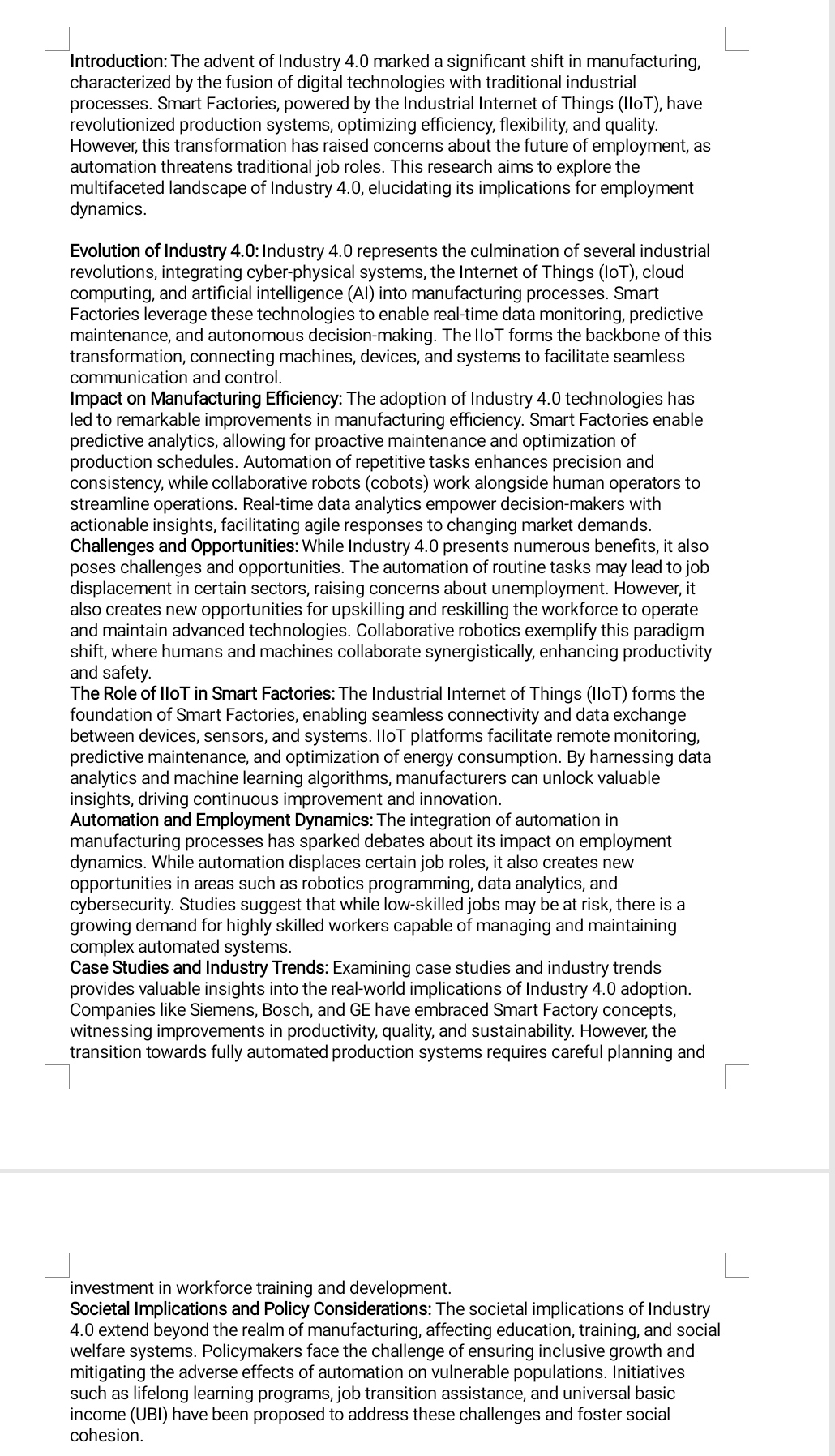Answered step by step
Verified Expert Solution
Question
1 Approved Answer
Introduction: The advent of Industry 4 . 0 marked a significant shift in manufacturing, characterized by the fusion of digital technologies with traditional industrial processes.
Introduction: The advent of Industry marked a significant shift in manufacturing, characterized by the fusion of digital technologies with traditional industrial processes. Smart Factories, powered by the Industrial Internet of Things IIOT have revolutionized production systems, optimizing efficiency, flexibility, and quality. However, this transformation has raised concerns about the future of employment, as automation threatens traditional job roles. This research aims to explore the multifaceted landscape of Industry elucidating its implications for employment dynamics.
Evolution of Industry : Industry represents the culmination of several industrial revolutions, integrating cyberphysical systems, the Internet of Things IOT cloud computing, and artificial intelligence AI into manufacturing processes. Smart Factories leverage these technologies to enable realtime data monitoring, predictive maintenance, and autonomous decisionmaking. The lloT forms the backbone of this transformation, connecting machines, devices, and systems to facilitate seamless communication and control.
Impact on Manufacturing Efficiency: The adoption of Industry technologies has led to remarkable improvements in manufacturing efficiency. Smart Factories enable predictive analytics, allowing for proactive maintenance and optimization of production schedules. Automation of repetitive tasks enhances precision and consistency, while collaborative robots cobots work alongside human operators to streamline operations. Realtime data analytics empower decisionmakers with actionable insights, facilitating agile responses to changing market demands. Challenges and Opportunities: While Industry presents numerous benefits, it also poses challenges and opportunities. The automation of routine tasks may lead to job displacement in certain sectors raising concerns about unemployment. However, it also creates new opportunities for upskilling and reskilling the workforce to operate and maintain advanced technologies. Collaborative robotics exemplify this paradigm shift, where humans and machines collaborate synergistically, enhancing productivity and safety.
The Role of IloT in Smart Factories: The Industrial Internet of Things IloT forms the foundation of Smart Factories, enabling seamless connectivity and data exchange between devices, sensors and systems. IloT platforms facilitate remote monitoring, predictive maintenance, and optimization of energy consumption. By harnessing data analytics and machine learning algorithms, manufacturers can unlock valuable insights, driving continuous improvement and innovation.
Automation and Employment Dynamics: The integration of automation in manufacturing processes has sparked debates about its impact on employment dynamics. While automation displaces certain job roles, it also creates new opportunities in areas such as robotics programming, data analytics, and cybersecurity. Studies suggest that while lowskilled jobs may be at risk, there is a growing demand for highly skilled workers capable of managing and maintaining complex automated systems.
Case Studies and Industry Trends: Examining case studies and industry trends provides valuable insights into the realworld implications of Industry adoption. Companies like Siemens, Bosch, and GE have embraced Smart Factory concepts, witnessing improvements in productivity, quality, and sustainability. However, the transition towards fully automated production systems requires careful planning and
investment in workforce training and development.
Societal Implications and Policy Considerations: The societal implications of Industry extend beyond the realm of manufacturing, affecting education, training, and social welfare systems. Policymakers face the challenge of ensuring inclusive growth and mitigating the adverse effects of automation on vulnerable populations. Initiatives such as lifelong learning programs, job transition assistance, and universal basic income UBI have been proposed to address these challenges and foster social cohesion.

Step by Step Solution
There are 3 Steps involved in it
Step: 1

Get Instant Access to Expert-Tailored Solutions
See step-by-step solutions with expert insights and AI powered tools for academic success
Step: 2

Step: 3

Ace Your Homework with AI
Get the answers you need in no time with our AI-driven, step-by-step assistance
Get Started


